Ferns of the Adirondacks:
Christmas Fern (Polystichum acrostichoides)
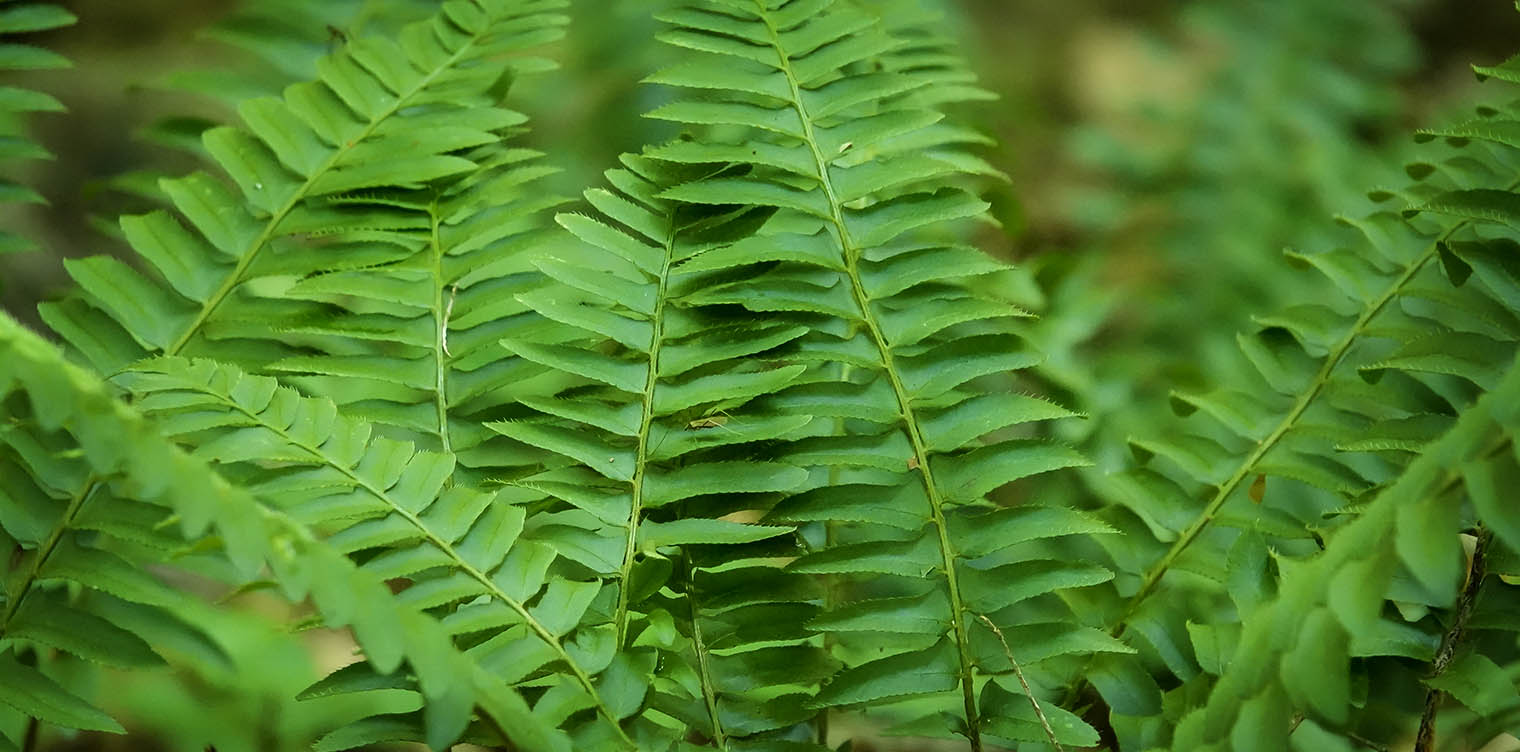
Christmas Ferns (Polystichum acrostichoides) are evergreen ferns with dark green, leathery fronds. They are found in the Adirondack Mountains of upstate New York, most commonly in hardwood forests under Sugar Maples.
The Christmas Fern is a member of the genus Polystichum (Holly Ferns). The Christmas Fern is one of two species in this genus that occurs in the Adirondacks. The other – Braun's Holly Fern (Polystichum braunii) – is much less common in our region.
- The genus name is derived from the Greek "polys," meaning "many", and "stichos," meaning "row". This is a reference to the rows of soriSorus: A cluster of spore-producing receptacles (sporangia), usually borne on the underside or margins of the pinnae or pinnules. (plural = sori) (spore-producing structures) that are common to this genus.
- The species name (acrostichoides) is a reference to a tropical genus of ferns with a similar arrangement of spore-producing structures.
The nonscientific name (Christmas Fern) refers to the fact that the fern's evergreen fronds were used for decoration during the Christmas holidays.
Identification of Christmas Ferns
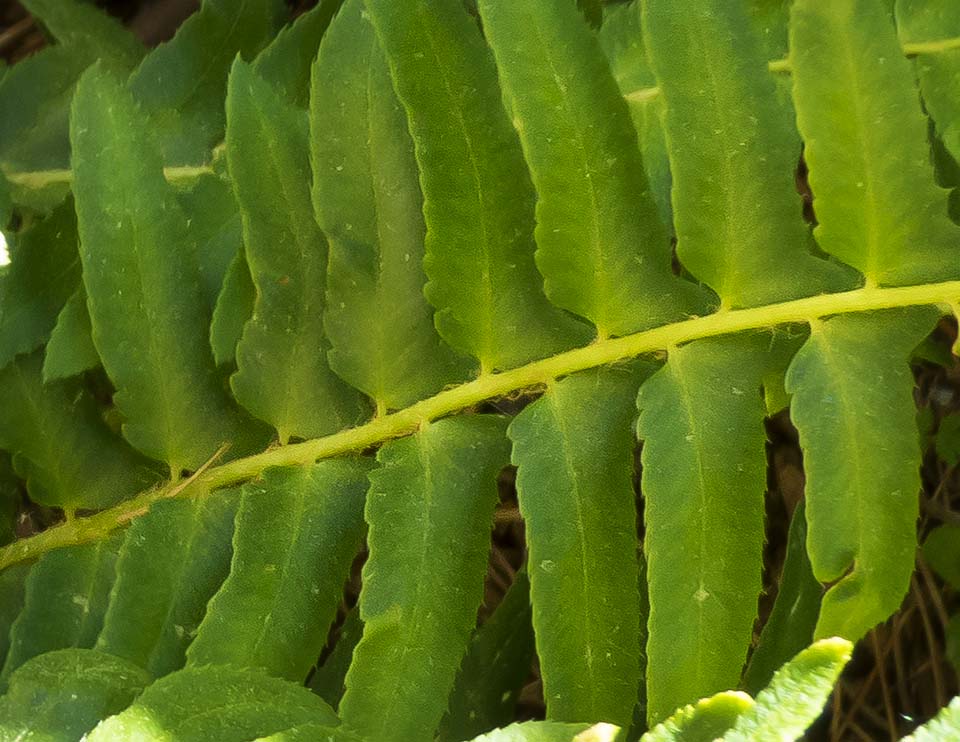
Christmas Ferns are medium-sized, evergreen ferns that grow 1½–2½ feet high in asymmetric clumps. The fronds arise from a central rhizome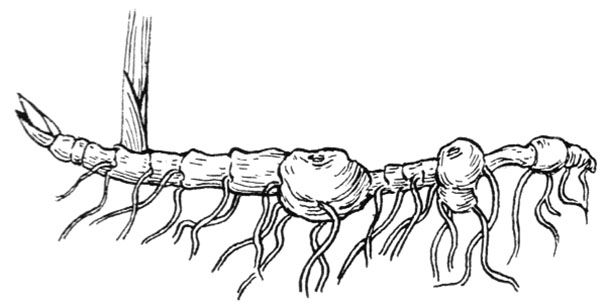 Rhizome: The modified subterranean stem of a plant that sends out roots and shoots from its nodes. Rhizomes are also called creeping rootstalks and rootstocks.. Christmas Ferns can form small, loose colonies or can occur individually.
Rhizome: The modified subterranean stem of a plant that sends out roots and shoots from its nodes. Rhizomes are also called creeping rootstalks and rootstocks.. Christmas Ferns can form small, loose colonies or can occur individually.
The Christmas Fern's rachis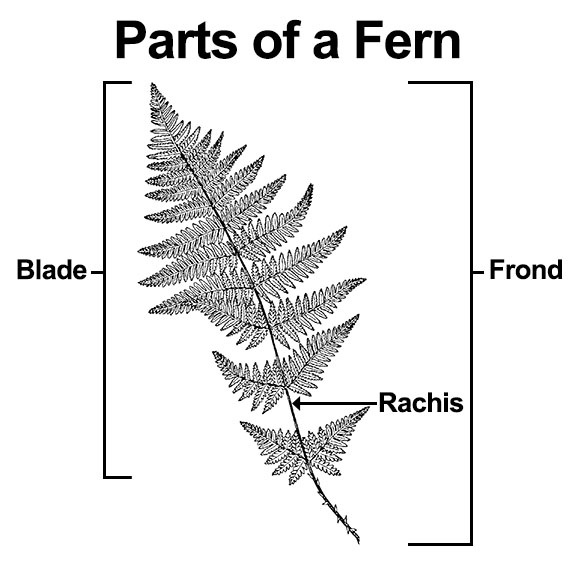 Rachis: The stalk within the blade (the expanded, leafy part of the frond). (central stalk) is light green to medium green and covered with white to light brown scales. The stipe
Rachis: The stalk within the blade (the expanded, leafy part of the frond). (central stalk) is light green to medium green and covered with white to light brown scales. The stipe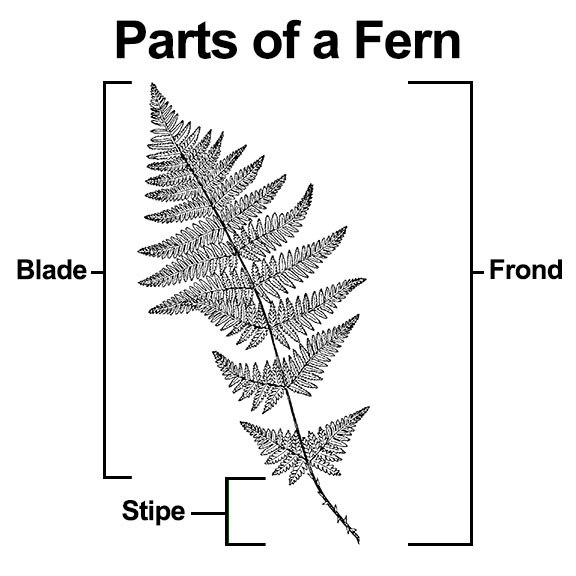 Stipe: The stalk below the blade (the expanded, leafy part of the frond). (the part of the stalk arising immediately from the root stock) is about ¼ to ½ of the length of the overall frond and is covered with coarse, brown scales.
Stipe: The stalk below the blade (the expanded, leafy part of the frond). (the part of the stalk arising immediately from the root stock) is about ¼ to ½ of the length of the overall frond and is covered with coarse, brown scales.
The Christmas Fern's fiddleheadsFiddlehead: The unfurling young frond of true ferns, which loosely resembles the ornate, curled end of a fiddle. (Synonym=crosier) (the unfurling young frond) appear in early spring among the recumbent green fronds of the prior year. The fiddleheads are light green and covered with silvery, white scales.
The dark green fronds Frond: The whole leaf of a fern. It includes the blade (the expanded leafy part of the frond) and the stipe (the stalk below the blade). of Christmas Fern are 12 to 32 inches long and 1½ to five inches wide. They are rather leathery in texture, with sparse hairs on the underside.
Frond: The whole leaf of a fern. It includes the blade (the expanded leafy part of the frond) and the stipe (the stalk below the blade). of Christmas Fern are 12 to 32 inches long and 1½ to five inches wide. They are rather leathery in texture, with sparse hairs on the underside.
Each frond has 20 - 35 pairs of pinnae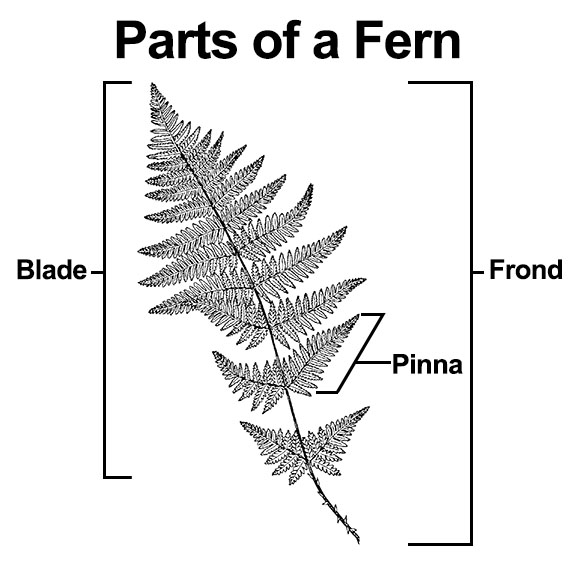 Pinna: A primary division of the blade (plural: pinnae). (leaflets). The two lowest leaflets are nearly opposite
Pinna: A primary division of the blade (plural: pinnae). (leaflets). The two lowest leaflets are nearly opposite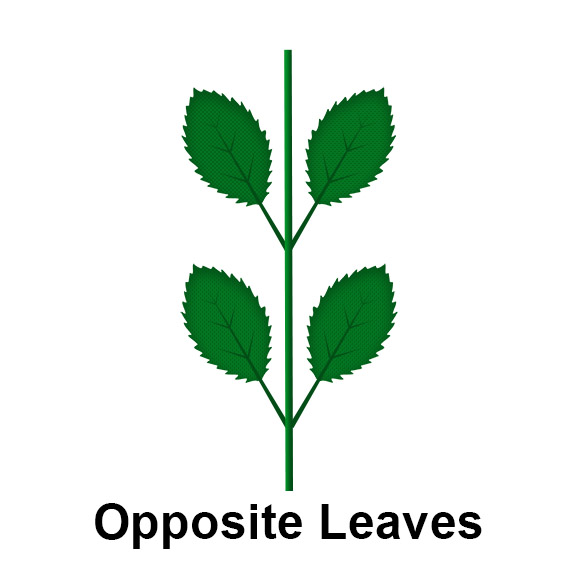 Opposite Leaves: Leaves occurring in pairs at a node, with one leaf on either side of the stem., while the rest are arranged alternately
Opposite Leaves: Leaves occurring in pairs at a node, with one leaf on either side of the stem., while the rest are arranged alternately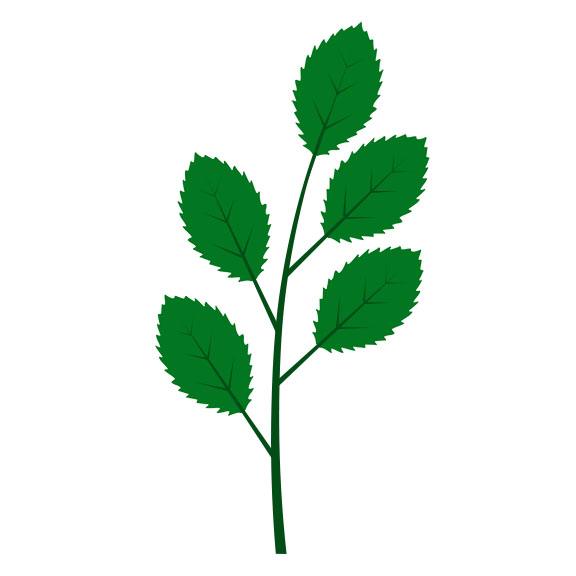 Alternate: An arrangement of leaves (or buds) on a stem (or twig) in which the leaves emerge from the stem one at a time. This often makes the leaves appear to alternate on the stem. along the rachis. Each leaflet is about 1½ inches long. Leaflets are oblong with a distinctive lobe at the base, resembling the toe of a Christmas stocking. Leaflets marginsThe structure of the leaf's edge. are usually finely serrated and bristle tipped, with teeth curving upward. However, there are variable forms, with some specimens displaying leaflets that are twisted or deeply cut.
Alternate: An arrangement of leaves (or buds) on a stem (or twig) in which the leaves emerge from the stem one at a time. This often makes the leaves appear to alternate on the stem. along the rachis. Each leaflet is about 1½ inches long. Leaflets are oblong with a distinctive lobe at the base, resembling the toe of a Christmas stocking. Leaflets marginsThe structure of the leaf's edge. are usually finely serrated and bristle tipped, with teeth curving upward. However, there are variable forms, with some specimens displaying leaflets that are twisted or deeply cut.
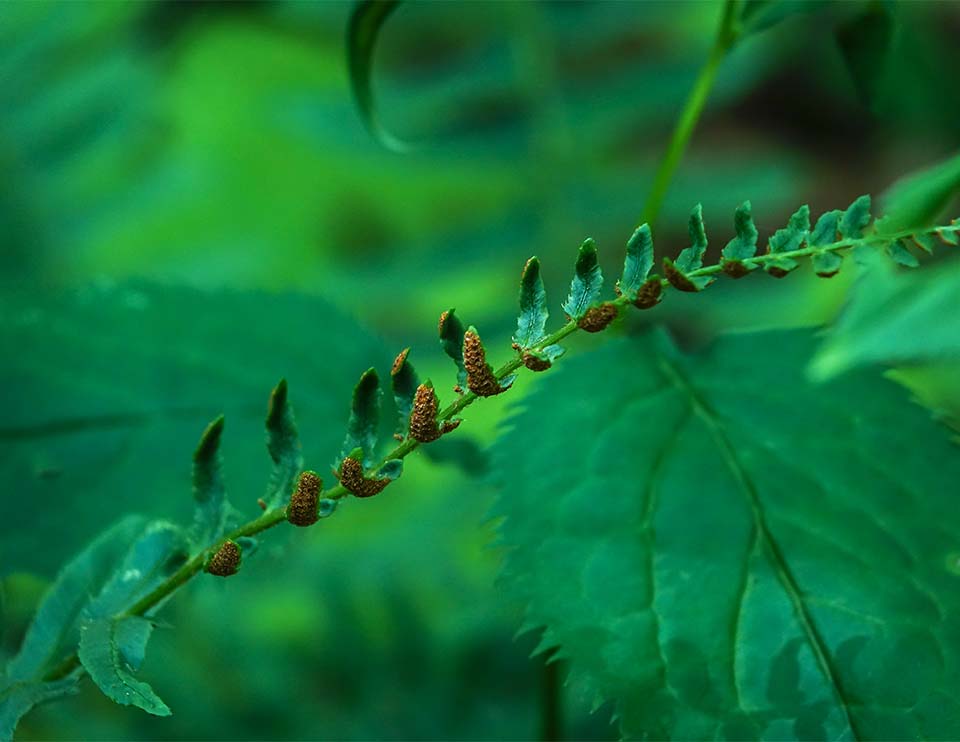
Christmas Ferns are dimorphicFrond dimorphism: Refers to a difference in ferns between the fertile and sterile fronds., meaning that the fertile fronds and sterile fronds are somewhat different.
- Fertile (spore-bearing) frondsFertile frond: A frond with sporangia (spore cases). are taller and more erect. Only the upper portion of the fertile frond bear spores. The upper leaflets of fertile fronds are much smaller that the sterile leaflets lower on the frond. When mature, the lower surface of these fertile leaflets are completely covered by rows of sori (spore-bearing structures). The sori are oblong and gradually expand to cover the entire surface, becoming covered with a circular indusiumIndusium: A thin layer of cells which usually covers and protects the sorus. (plural = indusia) and turning dark brown to blackish. The sori release their spores to the wind in the summer or early fall. Only the nonfertile portions of fertile fronds remain evergreen.
- Sterile frondsSterile frond: A frond without sporangia (spore cases). are shorter and more arching than fertile fronds. They remain evergreen over the winter, but are usually flattened by snow.
Uses of Christmas Ferns
Christmas Ferns were used by early New England settlers as a Christmas decoration. Although Christmas Ferns do not appear to have any edible uses, Native American groups used it for medicinal purposes. The Cherokee, for instance, used Christmas Fern externally to treat rheumatism, rubbing a decoction of the root on the affected area. An infusion of the plant was also taken internally for rheumatism. The Cherokee used Christmas Fern to treat stomachache, pneumonia, toothache, and chills. The Iroquois also used the plant to treat a wide range of medical problems, including rheumatism, consumption, convulsions, and fevers.
Wildlife Value of Christmas Ferns
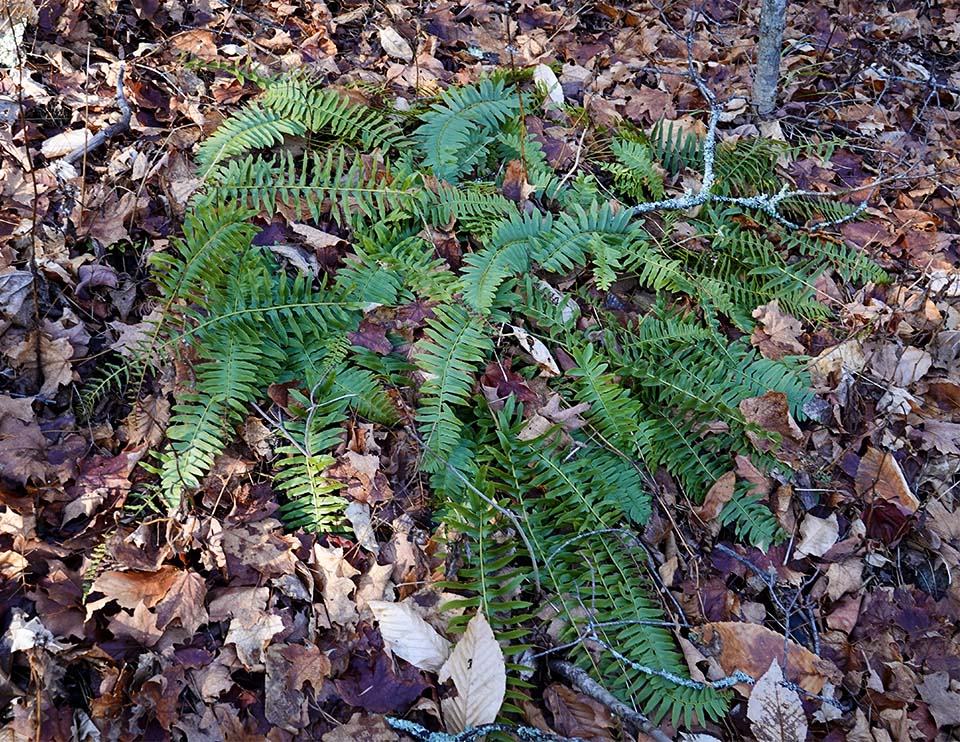
Christmas Ferns appear to have limited value for wildlife. In general, ferns are not a major food source for either mammals or birds. The small size of fern spores eliminates them from significance as a menu item. Many ferns are deciduous and so cannot provide a food source after the fronds have died back with the coming of cold weather.
Because the Christmas Fern is evergreen, it is of slightly more importance. During harsh winters when little else is available, White-tailed Deer may consume the evergreen fronds. The young fronds may be eaten in the spring by Wild Turkey and Spruce Grouse. Christmas Fern is reportedly a significant part of Ruffed Grouse diets during fall and winter. A few bird species (such as Ovenbirds and Veery) are reported to use the overwintered fronds of Christmas Fern as a nest site in the spring. The Christmas Fern is a larval host for the Serpentine Webworm.
Distribution of Christmas Ferns
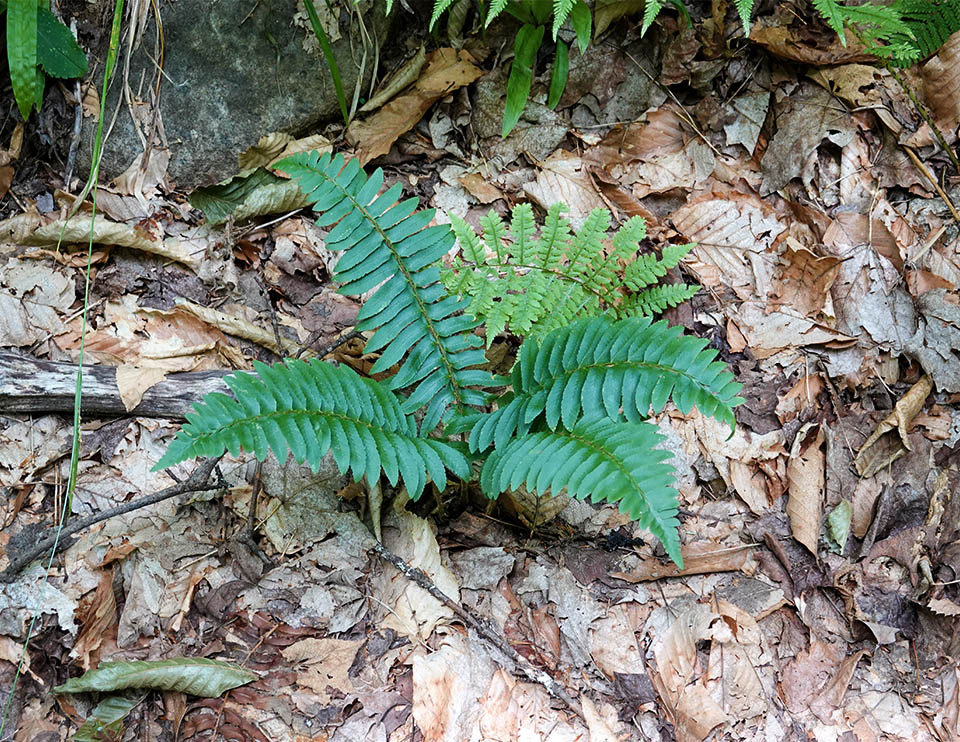
The Christmas Fern is one of the most common ferns in the eastern United States. These ferns are found from Nova Scotia to southern Ontario, south to Florida and eastern Texas. This fern is listed as threatened in Minnesota and as a plant of special concern in Wisconsin.
The Christmas Fern is found throughout New York State, where it is among the many ferns listed as exploitably vulnerable. Vouchered plant specimens have been registered for nearly all counties in the state, including all counties within the Adirondack Park Blue Line.
This pattern is consistent with the map of iNaturalist observations of Christmas Ferns in New York State. The insights gleaned through iNaturalist should, of course, be tempered with an awareness that the data reflect the number of observers willing to submit photos and how easily recognized a particular species is, rather than the actual abundance of the species. With this caveat in mind, it appears that Christmas Ferns are fairly common throughout much of the state. As of early December 2020, there were 1,700 research-grade observations of Christmas Ferns in the state. This compares with nearly 15,000 observations of all species of ferns, suggesting that this species is one of the more common (and more easily recognized) ferns.
The Christmas Fern appears somewhat less widespread in the Adirondack Mountains. The lower density of observations reflects partly the lower population density in our region and partly the lengthy period of heavy snow cover obscuring everything growing on the forest floor. As of early December 2020, there were 71 research-grade observations of Christmas Ferns within the Adirondack Park Blue Line, compared to more commonly-reported species, such as Intermediate Wood Fern (138 observations) and Sensitive Fern (124 observations).
Habitat of Christmas Ferns
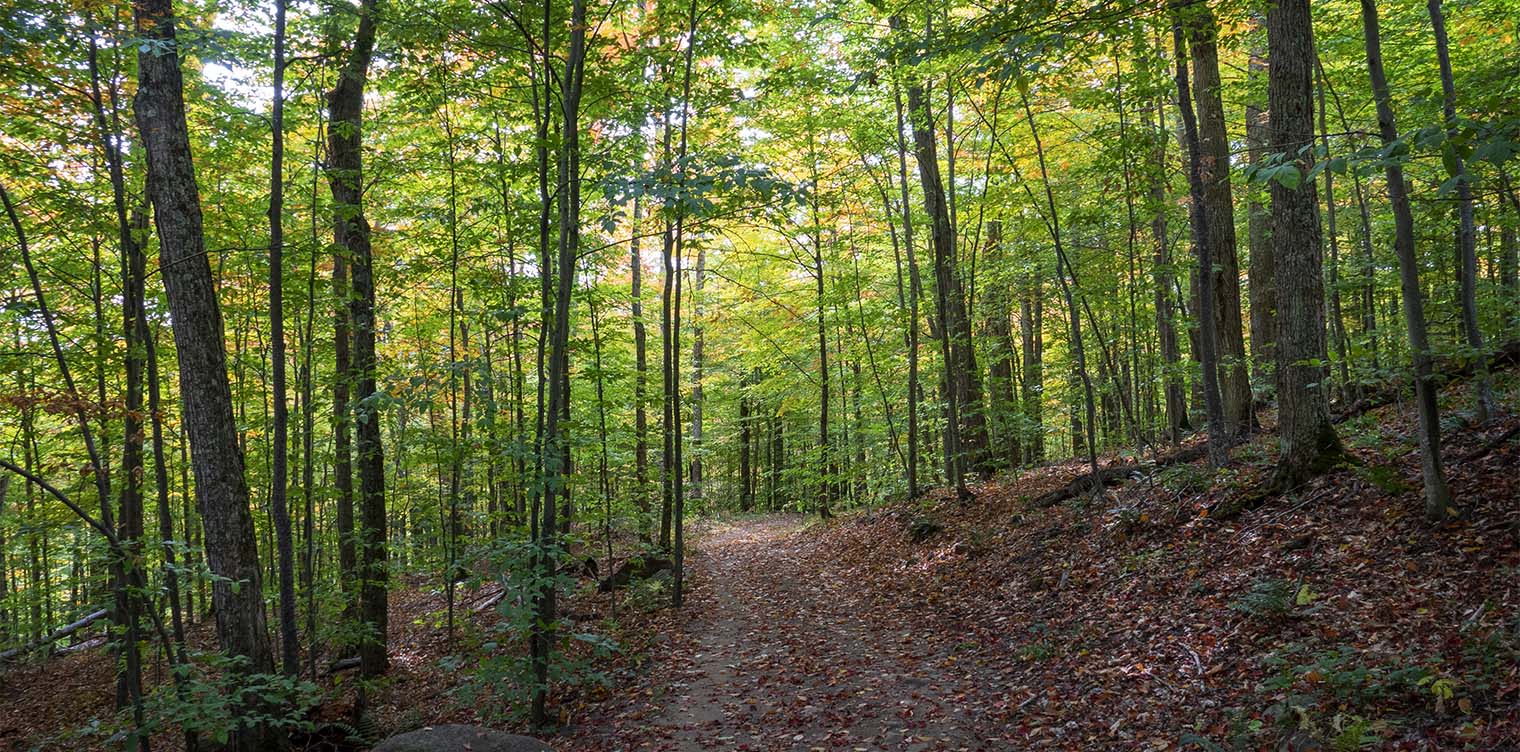
The Christmas Fern is classified as a Facultative Upland plant (FAC), meaning that it usually occur in non-wetlands, but may occur in wetlands. In terms of site requirements, this fern is fairly shade tolerant, but can tolerate sun if the soil is moist. It is found in a variety of shaded habitats, including woodlands, stream banks, and rocky slopes. In New York State, Christmas Fern is most commonly found in hardwood forests with richer soils. In the more northern parts of the state, it becomes less common and more restricted to rich and rocky soils.
In the Adirondack Mountains, Christmas Ferns are found in several ecological communities, including:
One of the likeliest places to find Christmas Ferns is the beech-maple mesic forest. This is a northern hardwood forest where the two codominant species are Sugar Maple and American Beech. These forests are generally found in areas with moist, well-drained, slightly acidic soils.
- Other deciduous trees found here include Red Maple and Yellow Birch. A few Eastern Hemlocks and Red Spruce trees may also be found.
- In the understory of the Beech-Maple Mesic forest, look for characteristic shrubs/small trees such as Hobblebush, Striped Maple, Maple-leaved Viburnum, and Alternate-leaved Dogwood.
- Characteristic wildflowers include Canada Mayflower, Starflower, Common Wood Sorrel, Partridgeberry, Foamflower, Whorled Wood Aster, Indian Cucumber-root, Wild Sarsaparilla, Jack-in-the-Pulpit, and Sessile-leaved Bellwort, as well as spring ephemerals such as Trout Lily.
- Other ferns that flourish in this habitat together with Christmas Ferns include Marginal Wood Fern, Intermediate Wood Fern, and Spinulose Wood Fern.
Among the trails covered here, look for Christmas Ferns growing under Sugar Maples on the Sugar Maple Trail at Heaven Hill and the Rocky Knob Trail at Henry's Woods.
List of Adirondack Ferns
References
Michael Kudish. Adirondack Upland Flora: An Ecological Perspective (The Chauncy Press, 1992), pp. 42, 60, 87.
Boughton Cobb. A Field Guide to Ferns and their Related Families. Northeastern and Central North America. Second Edition (Houghton Mifflin Company, 2005), pp. 197-199
Michael Burgess. A Field Guide to the Ferns of New England and Adjacent New York, pp. 13, 23, 112-113. Undated. Retrieved 16 February 2017.
Richard Mitchell. Atlas of New York State Ferns (New York State Museum, 1984), p. 22. Retrieved 15 February 2017.
Eugene C. Ogden. Field Guide to Northeastern Ferns (New York State Museum, 1981), p. 99-100. Retrieved 15 February 2017.
William J. Cody and Donald M. Britton. Ferns and Fern Allies of Canada (Research Branch. Agriculture Canada, 1989), pp. 184-187. Retrieved 19 February 2017.
William J. Cody. Ferns of the Ottawa District (Research Branch. Agriculture Canada, 1978), p. 73-74 Retrieved 10 January 2018.
David B. Lellinger. A Field Manual of the Ferns & Fern Allies of the United States and Canada (Smithsonian Institution Press, 1985), pp. 274-275. Retrieved 9 December 2020.
Steve W. Chadde. Northeast Ferns: A Field Guide to the Ferns and Fern Relatives of the Northeastern United States (CreateSpace Independent Publishing Platform, 2013), pp. 155-157.
Edgar T. Wherry. The Fern Guide. Northeastern and Midland United States and Adjacent Canada (Doubleday & Company, Inc., 1961), pp. 100-101. Retrieved 9 December 2020.
William Cullina. Native Ferns, Moss & Grasses (Houghton Mifflin Company, 2008), pp. 82-83.
George Henry Tilton. The Fern Lover's Companion. A Guide for the Northeastern States and Canada (Little, Brown, 1923), pp. 107-110. Retrieved 10 January 2018.
R.C. Benedict, "An Adirondack Fern List," American Fern Journal, Volume 6, Number 3, July-September 1916, pp. 81-85. Retrieved 10 January 2018.
New York Flora Association. New York Flora Atlas. Christmas Fern. Retrieved 9 December 2020.
Integrated Taxonomic Information System. Polystichum acrostichoides. Retrieved 9 December 2020.
United States Department of Agriculture. The Plants Database. Christmas Fern. Polystichum acrostichoides. Retrieved 9 December 2020.
Flora of North America. Polystichum acrostichoides. Retrieved 9 December 2020.
NatureServe Explorer. Online Encyclopedia of Life. Christmas Fern. Polystichum acrostichoides. Retrieved 9 December 2020.
iNaturalist. Christmas Fern. Polystichum acrostichoides. Retrieved 9 December 2020.
iNaturalist. Adirondack Park Observations. Christmas Fern. Polystichum acrostichoides. Retrieved 9 December 2020.
Native Plant Trust. Go Botany. Christmas Fern. Polystichum acrostichoides. Retrieved 9 December 2020.
New York State. Department of Environmental Conservation. New York Natural Heritage Program. Ecological Communities of New York State. Second Edition (March 2014), pp. 107-108, 119-121. Retrieved 17 October 2015.
New York Natural Heritage Program. 2020. Online Conservation Guide for Acidic Talus Slope Woodland. Retrieved 9 December 2020.
New York Natural Heritage Program. 2020. Online Conservation Guide for Beech-Maple Mesic Forest. Retrieved 10 December 2020.
New York Natural Heritage Program. 2020. Online Conservation Guide for Hemlock-Northern Hardwood Forest. 9 December 2020.
New York Natural Heritage Program. 2020. Online Conservation Guide for Maple-Basswood Rich Mesic Forest. 9 December 2020.
New York State. Adirondack Park Agency. Preliminary List of Species Native Within the Adirondack Park Listed Alphabetically by Scientific Name and Sorted by Habit. Volume 1. Updated 10.23.2006, p. 59. Retrieved 26 January 2017.
Connecticut Botanical Society. Christmas Fern. Polystichum acrostichoides. Retrieved 9 December 2020.
University of Wisconsin. Flora of Wisconsin. Christmas Fern. Polystichum acrostichoides. Retrieved 9 December 2020.
Minnesota Wildflowers. A Field Guide to the Flora of Minnesota. Christmas Fern. Polystichum acrostichoides. Retrieved 9 December 2020
Illinois Wildflowers. Grasses, Sedges, & Non-Flowering Plants. Christmas Fern. Polystichum acrostichoides. Retrieved 9 December 2020.
Illinois Wildflowers. Vertebrate Animal & Plant Database. Christmas Fern. Polystichum acrostichoides. Retrieved 9 December 2020.
Illinois Wildflowers. Plant-Feeding Insect Database. Christmas Fern. Polystichum acrostichoides. Retrieved 9 December 2020.
Eloise Butler Wildflower Garden. The Friends of the Wild Flower Garden. Christmas Fern. Polystichum acrostichoides. Retrieved 9 December 2020.
Lady Bird Johnson Wildflower Center. Christmas Fern. Polystichum acrostichoides. Retrieved 9 December 2020.
New York State Department of Environmental Conservation. Winter Deer Foods. Retrieved 9 December 2020.
Alexander C. Martin, Herbert S. Zim, and Arnold L. Nelson. American Wildlife & Plants. A Guide to Wildlife Food Habits (Dover Publications, 1951), p. 369. Retrieved 9 December 2020.
John Eastman, "Ruffed Grouse," The Eastman Guide to Birds: Natural History Accounts for 150 North American Species. Kindle Edition. (Stackpole Books, 2012).
Plants for a Future. Polystichum acrostichoides. Retrieved 9 December 2020.
Steven Foster and James A. Duke. A Field Guide to Medicinal Plants and Herbs of Eastern and Central North America. Second Edition. (Houghton Mifflin Harcourt, 2000), pp. 344-345.
University of Michigan. Native American Ethnobotany. A Database of Foods, Drugs, Dyes and Fibers of Native American Peoples, Derived from Plants. Polystichum acrostichoides. Retrieved 9 December 2020.
The Cornell Lab of Ornithology. Birds of the World. Subscription web site. Ovenbird; Ruffed Grouse; Veery. Retrieved 9 December 2020.
Iowa State University. BugGuide. Serpentine Webworm. Retrieved 9 December 2020.
Allen J. Coombes. Dictionary of Plant Names (Timber Press, 1994), p. 148.
